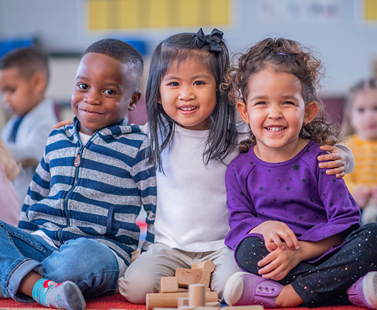Social-emotional Health and Development

2) How do I foster the social-emotional health and development of Multilingual Learners?
Social-emotional support is critical for all young learners, particularly for Multilingual Learners (MLs). Children who speak a language other than English may need additional support from teachers to make sure they feel comfortable and included in the classroom and to ensure they have meaningful access to all learning opportunities. Engaging with children and families in a friendly and accepting way helps foster self-confidence and family pride and conveys a message of caring and respect for the family and child.21 Inviting families to contribute to their children’s education promotes social-emotional well-being. Additionally, using the home language and incorporating their culture in classroom activities is a positive message that gives social-emotional support for young ML children. In fact, research shows that teachers’ use of the home language is related to social-emotional competence among young MLs.22 ML children should be encouraged to speak in their language of choice and educators can provide space for their full range of expression, whether this is verbal or non-verbal, and opportunities for ML children to share their own language with the class.23 Classrooms and schools should be responsive to the strengths, needs, and identities of MLs, and build upon their strengths to create a safe and affirming learning environment (see EL Roadmap, Principle One), including drawing from anti-bias training and trauma-informed practices. Teachers should make it a point to become familiar with available culturally and linguistically responsive resources in order to assist families with health, mental health, and basic needs (e.g., nutrition, housing, legal resources). Such efforts increase awareness of and respect for different languages and cultures and foster an inclusive and diverse classroom culture that celebrates the strengths and differences of all children and families.
Sample Lesson Plan & Resource Walk
Access additional resources developed to introduce teachers to the work of supporting MLs’ social-emotional health and development. These activities, a sample lesson plan and a resource walk, are designed to support learning about this instructional topic area through structured exploration of resources on the website. Click the buttons below to access these resources.
Strategies in action



You can search across all strategies by keyword on our Research Search page. Give it a try!
Evidence-Based Strategies and Resources
2A) Engage individually with ML children in a warm and inclusive way. Take time to build trust, respect, and strong relationships with children and their families.
TK
30-60 minutes
TK
15-30 minutes
TK
15-30 minutes
TK
Under 5 minutes
TK
15-30 minutes
Other
Educator Toolkit: My Name, My Identity- Creating an Inclusive and Respectful School Community
TK
15-30 minutes
Document
TK
15-30 minutes
Document
Tip Sheet: How to Support Your Child’s Social-Emotional Health – 8 Tips (in 16 languages)
TK
5-10 minutes
Video & Video Guide
Video & Video Guide: Adventures in Preschool Second Language Acquisition
TK
15-30 minutes
2B) Help ML children join fully in group learning settings by providing opportunities to have a role in small and large groups.
Website
Website Article: Adapting Morning Meeting Greeting for English Learners
TK
Under 5 minutes
Video
Video: A Study of the Play of Dual Language Learners in an English-Speaking Classroom
TK
5-10 minutes
2C) Provide opportunities for ML children to build friendships and relationships and to meaningfully participate in peer social interactions.
Video
Video: A Study of DLLs’ Play in an English-Speaking Classroom
TK
5-10 minutes
Website
Website Article: Adapting Morning Meeting Greeting for English Learners
TK
Under 5 minutes
Video
Video: Model Curriculum for English Learners- How Do I Feel? (Kindergarten)
5-10 minutes
Other
Under 5 minutes
Video & Video Guide
Video & Video Guide: Using Reciprocal Teaching to Engage 3rd-Grade Readers
5-10 minutes
Video
5-10 minutes
Video
Video: A Study of the Play of Dual Language Learners in an English-Speaking Classroom
TK
5-10 minutes
TK
5-10 minutes
5-10 minutes
TK
5-10 minutes
TK
Under 5 minutes
2D) Provide opportunities for ML children who speak the same home language to serve as peer support for each other.
Website
Website Article: Promote Peer Support and Interaction
TK
5-10 minutes
Website
Website Article: The Home Language-An English Language Learner’s Most Valuable Resource
5-10 minutes
10-15 minutes
Website
Website Article: Six Strategies to Help ELLs Succeed in Peer Learning and Collaboration
5-10 minutes
TK
5-10 minutes
Other
TK
5-10 minutes
Other
Blog: Equity Measures in Dual Language Education – Separation of Language
TK
5-10 minutes
2E) Provide adequate time for informal learning and exploration to help develop relationships within the classroom.
Video
Video: A Study of DLLs’ Play in an English-Speaking Classroom
TK
5-10 minutes
Website
Website Article: Promote Peer Support and Interaction
TK
5-10 minutes
Website
Website Article: Adapting Morning Meeting Greeting for English Learners
TK
Under 5 minutes
Other
Educator Toolkit: My Name, My Identity- Creating an Inclusive and Respectful School Community
TK
15-30 minutes
Website
Website Article: Six Strategies to Help ELLs Succeed in Peer Learning and Collaboration
5-10 minutes
Other
Under 5 minutes

Strategies are interrelated
Individual strategies across the different instructional topics are interconnected and should be implemented together, in a purposeful and connected manner throughout instruction, and not in isolation. Make sure to also consider your classroom or school’s language model when implementing the strategies and adapt accordingly.
Visit how to use this site >

Alignment with Existing California Educator Guidance Documents & Resources
The Multilingual Learning strategies are closely aligned with existing guidance documents and resources for educators in California. Learn how Social-emotional Health and Development strategies align with these existing resources, or to see how the standards align across all strategies, visit the alignment reference guide page.

